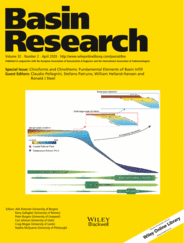
Full text loading...
 , Stefano Patruno2
, Stefano Patruno2 , William Helland‐Hansen3, Ronald J. Steel4, Fabio Trincardi5
, William Helland‐Hansen3, Ronald J. Steel4, Fabio Trincardi5
This special issue dealing with the recent advances on modern and ancient clinoform‐stratified sedimentary successions arises from a European Geoscience Union (EGU) session “Clinoform drivers and stratigraphic products in siliciclastic and carbonate successions”, Vienna, April 2018. Clinoforms and clinothems represent a dominant architectural style of strata in many sedimentary environments, including deltaic and nondeltaic shorelines in both marine and lacustrine settings, and are one of the key building blocks of the sedimentary record. This Special Issue in Basin Research aspires to represent a step forward in understanding formation and preservation of these fundamental stratigraphic elements. As this Special Issue documents, a comprehensive understanding of clinoformal strata requires a multidisciplinary and multi‐scale approach. Sixteen papers present case studies from a variety of tectonic settings worldwide, investigated with an array of methods, including seismo‐stratigraphy, well logs, cores, high‐resolution biostratigraphy, outcrop studies and modern bathymetric data. While observations document sedimentary processes and products in sedimentary basins, numerical models are necessary to provide a quantitative basis for the extrapolation of these processes and strata at different temporal and spatial scales. The papers highlight at least five main research avenues that we briefly introduce and discuss below: (a) clinoforms and clinothems as sedimentary archives; (b) the nested nature of clinoformal strata and implications for the trajectory of the rollover point(s); (c) quantitative clinoform parameters and dynamic indices; (d) architecture, growth and sequence stratigraphy of marine versus lacustrine clinoformal strata; and (e) clinoforms and geological time. This introduction also contains brief descriptions of each paper of the Special Issue.
,Clinoforms and clinothems represent the dominant architectural style in many sedimentary basins and are widely recognized as one of the fundamental building blocks of the stratigraphic record.

Article metrics loading...

Full text loading...
References


Data & Media loading...

